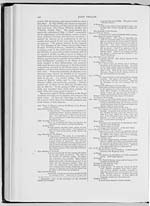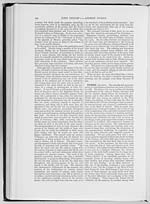243
Daughters of the Alhambra.
Two girls at a window of Moorish design.
1859�A Huff.
A large composition, presenting a group of bpan-
ish holiday-makers, of whom the principal and
centre figure is a girl who stands pouting and
angry, while her companion wishes her to turn
round and speak to a man on horseback (her
husband or lover), with whom she appears to
have quarrelled.
Portrait of Augustus L. Egg, A.R.A.
A small picture. The subject is seated with a
terrier on his knee.
1860�The Marriage of the Princess Royal with the Prince
Frederick William of Prussia, January 25, 1858.
On the left is the Archbishop, and before him
kneel the Prince and Princess. Immediately
behind the latter the bridesmaids are kneeling,
and towards the right stand the Queen, the
Prince Consort, the Prince of Wales, and other
members of the royal family, with a numerous
attendance. On the left are the members of
the Prussian court, and in the back-ground a
number of figures more or less in shade. This
picture has been engraved on a large size in
the line manner by Blanchard.
Prayer.
A Spanish woman�a fruit-seller�sits in a church
in fervent prayer; near her is a girl who is flirt-
ing her fan and showing little trace of peni-
tence. The artist's diploma work, deposited in
the Royal Academy on his election as academi-
cian.
1861�Spanish Gossips at a Well.
Some men�one of them a muleteer�have met
two buxom girls at a fountain, and are banter-
ing and jesting with them. One of the girls
stands in pretended dignity, while the head of
the other is half-hidden behind her; and the
muleteer has withdrawn his cigar from his mouth
to give utterance to some jest.
1862�A Spanish Volunteer.
The volunteer before setting out is embracing his
wife, who clings closely to him, while his mother
holds his gun.
Doubtful Fortune!
A Spanish lady is consulting a gipsy fortune-tel-
ler, and drawing a card from a pack held by
her.
Water Drinkers.
Two ladies stop in the street to drink water
poured for them from a jar by a sturdy fellow,
who, cigarette in mouth, raises the vessel on
his knee. The figures are half-length.
Dolores.
1863�Agua Bendita.
A scene at the porch of a. church in Spain. Be-
fore the holy-water vessel fixed near the en-
trance, two parties have met�a young lady
with her infant and her husband, and a gipsy
woman, who kneels and receives the holy water
from the child's fingers.
The House of Commons, 1860.
The most prominent figure is that of the prime
minister, Lord Palmerston, who stands in the
act of addressing the House; in various parts
are grouped the other important members of the
House. All are portraits, and the difficulties
incident to the pictorial rendering of such a
scene are very successfully overcome. Painted
for the late Speaker. Engraved on a large size
in mixed style by T. O. Barlow.
1864�La Gloria�a Spanish Wake.
At one side of the picture an open door gives a
glimpse into a partly darkened room, where on
a couch lies the dead body of a child, crowned
with flowers. Near the door crouches the
young mother, whose face and action strik-
ingly express her sense of bereavement. Two
women address her with soothing words, and
entreat her to join a noisy throng of friends and
neighbours who dance and sing in the street,�
their mode of showing their belief that the child
is now in glory.
Portrait of the Earl of Dalhousie.
1865�The Early Career of Murillo, 1634.
A market-place in the great square of a town.
Murillo, who is little more than a boy, has come
among others to dispose of his wares�little
pictures of saints, male and female. Two
friars have halted to look at his work, and
one of them has taken a picture into his hand
to examine it. A Spanish peasant woman with
a child in her arms is staring eagerly at the
picture which is under judgment. On the left
of the woman is a fellow seated sideways on a
mule, who munches his dinner as he swings
along.
A Prima Donna in the Character of Rosina.
Fan in hand and peeping sideways at a letter.
1866�The Right Hon. Duncan M'Neill, of Colonsay,
Lord President of the Court of Session; to be
placed in the Parliament House, Edinburgh.
A Chat round the Brasero.
A Spanish priest is telling stories to a number of
women as they sit together round a brazier in
the middle of a room. He has paused to light
his cigarette, and also to enjoy the laughter his
story has caused. An old woman is shaking
with laughter; a dark brown damsel covers her
mouth, while another young woman rolls back-
ward in her chair, giving full vent to her merri-
ment.
Portrait of Mrs. Cooper.
1867�"O Nannie, wilt thou gang wi' me?"
A lad and lass in confidential converse.
A Highland Lassie reading.
Antonia. A half-length figure.
Besides these, two paintings, said to be the last
from the easel of this great artist, ought still to be
mentioned. They are illustrative of the national
lottery in Spain, the one being the "Purchase of the
Tickets," the other "The Results of the Drawing."
In the first all are rushing helter-skelter to the pur-
chase, while the face of every buyer is lighted with
hope; in the second, there are the few happy counten-
ances of the winners, while the looks of the many
are distorted with every shade from disappointment to
despair. The subjects are treated not only with the
humour but much of the moral power of Hogarth.
These paintings were exhibited, not at the Royal
Academy, but by the Messrs. Agnew in the summer
of 1867.
While in his earlier years Phillip industriously
painted portraits for a living, in his after-years, when
he had gained both fame and emolument, he painted
portraits for enjoyment, when he found a subject
worthy of his powers, or one that personally inter-
ested him.
He was fond "of presenting to his friends sketches
or portraits of themselves or of relatives dear to
them; and the houses of many who had the honour
and pleasure of his acquaintance are thus enriched
by productions of his ready and industrious pencil,
which could be readily sold at high prices did not
their owners prefer to cherish them as memorials of
the painter's friendship. Indeed, his devotion to his
art for its own sake was so great as to induce in him
an almost blamable disregard of fit remuneration�
and certainly in the course of his work he never con-
sidered the rate of payment, but bent his best powers
to everything he undertook. At the same time, for
fifteen or sixteen years all that he did secured high
prices. He was overwhelmed with orders, and it
had long been easier to get from him a specimen of
his work for love than for money. At the time of
his death he had work before him for many years�
having on hand, it is understood, commissions to the
amount of �20,000. He left a number of noble
works in progress, many of them of Spanish subjects,
but some of the very latest are Scotch. Among the
former of these may be mentioned "Spanish Boys
Playing at Bull-fighting." In this large painting,
the spirit of the boys, while engaged in an imitation
of the great national pastime, is admirably deline-
ated; all are animated by chivalrous ardour mixed
with boyish glee; and while a beautiful woman is
withdrawing hastily from the uproar, a veteran bull-
fighter seems to be warming into "a boy again" at
the spectacle. This painting, executed in his best
style, Phillip brought from Spain. He received a
commission from the Royal Association for the Pro-
motion of the Fine Arts to finish it, with a view to
its being placed in the National Gallery of his native

![]() Universal Viewer |
Universal Viewer | ![]() Mirador |
Large image | Transcription
Mirador |
Large image | Transcription
![]()

